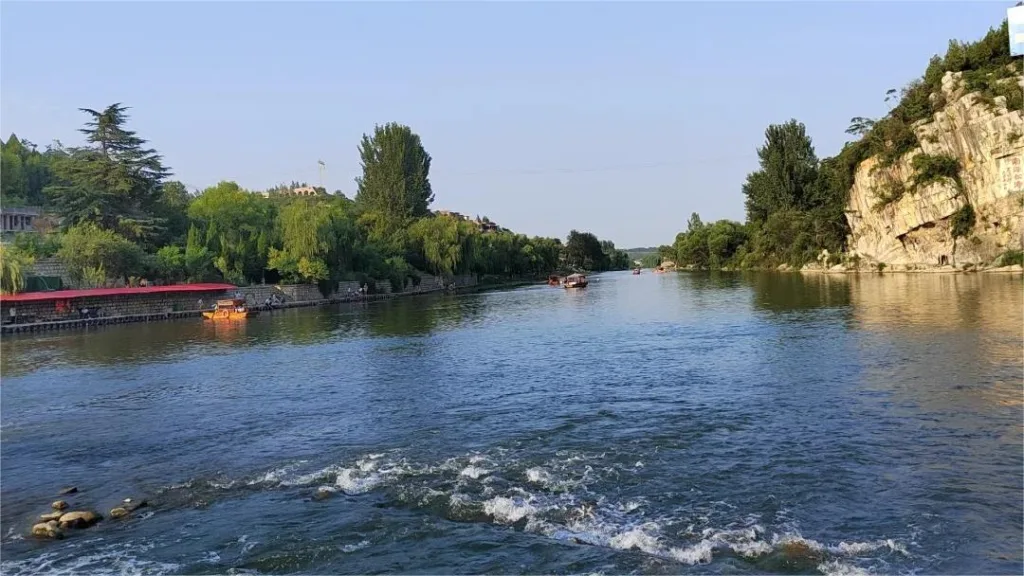Little South Sea Scenic Area, Anyang - Bilhete, horário de funcionamento, localização e destaques


Located in Shanying Town, Anyang City, the Little South Sea Scenic Area (小南海风景区, Xiaonanhai Lake Scenic Area) covers approximately 8 square kilometers. Its main attraction lies in the picturesque scenery of the Little South Sea Reservoir, with its sparkling waters, cascading springs, and scattered ancient landmarks. In ancient times, this gorge boasted a majestic water flow and expansive surface, resembling a vast ocean. Situated to the south of the ancient city of Ye, it earned the name Little South Sea.
Nestled in the valley of the southwest, the Little South Sea Reservoir is surrounded by mountains. Its vast expanse of azure water reflects the towering peaks, with fishing boats gently bobbing on the waves and the dam resembling a mountain range, presenting a magnificent panorama. The waters teem with fish, shrimp, crabs, and eels, while wild ducks dot the surface. On the eastern side of the dam stands a statue of Yu the Great, while a resort village graces the western side. Along the reservoir’s edge, pleasure boats are available for visitors to enjoy aquatic adventures.
Índice
- Informações básicas
- Localização e transporte
- Highlights of Little South Sea
- Outras atracções em Anyang Suburbs
Informações básicas
| Duração estimada da excursão | Meio dia |
| Preço do bilhete | Grátis |
| Horário de funcionamento | 24 horas por dia durante todo o ano |
Localização e transporte
The Little South Sea Scenic Area is situated approximately 25 kilometers southwest of the urban area of Anyang City, in the vicinity of Shanying Town, Anyang County. Travelers can easily reach the area by taking a bus from Anyang Bus Station bound for Shanying Town. The journey takes a little over an hour.
Highlights of Little South Sea
Nanhai Ancient Temple

Located at the foot of Mount Niutou on the northern side of Little South Sea, Nanhai Ancient Temple dates back to the Tang Dynasty and serves as a Taoist sanctuary. Its architectural layout includes the Mountain Gate, Lingguan Hall, Buddha Hall, Bixia Pavilion, Shengren Pavilion, and Daoist House, all arranged in a majestic manner. The temple features traditional gray brick and tile structures, with the Daoist House exuding an ancient simplicity. Surrounded by verdant cypress trees and colorful flowers, the temple compound offers a serene atmosphere. The Shengren Pavilion, with its square plan and intricate architectural details, houses a statue of Confucius on the upper level. The Bixia Pavilion, standing at 10 meters tall with two stories, showcases exquisite green glazed tiles on its roof. Visitors can ascend stone steps to admire the panoramic view of the distant mountains and waters from its summit.
Templo Taoísta de Changchun

Situated in the Baiyu Valley on the western side of the Little South Sea Scenic Area, Changchun Taoist Temple was established during the Tang Dynasty and later renamed in the Yuan Dynasty. The temple complex includes the Mountain Gate, Taoist Theater, Small Square, Jade Spring Holy Water, Lingguan Hall, Wealth God Hall, Guanyin Hall, Qiu Ancestor Cave, Jade Emperor Hall, and the Three Skies Hall and Three Purities Hall on both sides, all displaying grandeur and elegance. The Jade Spring water, rich in minerals and renowned throughout northern Henan Province, flows in abundance. Near the northeast side of Changchun Taoist Temple, on the eastern foothills, lies the ancient human dwelling known as the Primitive People’s Cave. Despite being excavated twice by the Chinese Academy of Sciences Institute of Archaeology, remnants such as fossilized animal bones of the latest leopards, ash, spotted deer, antelope, wild boar, water buffalo, and wild donkey, as well as stone tools, still remain. After approximately 12,000 years of human occupation, the cave was abandoned due to continuous rockfalls from its ceiling.
Northern Qi Grottoes

Situated at the southern foothills of Mount Guigai on the northern side of Little South Sea, three Northern Qi Grottoes remain. The West Cave’s entrance is adorned with carvings of lotus flowers, green dragons, golden-winged birds, and human figures with tiger heads. Inside, there are bas-reliefs of seated Buddhas, disciples, and standing Bodhisattvas. On the outside, there are 40 finely carved statues of donors on the southern side. The Central Cave’s entrance features carvings of lotus flowers, green dragons, golden-winged birds, and guardian deities. Inside, there are bas-reliefs of Buddhas, Bodhisattvas, and disciples, while the walls are adorned with numerous shallow carvings depicting Buddhist stories. On the eastern side of the north wall, there are shallow carvings of prominent figures from the Northern Qi Dynasty, including the Buddhist national master, the founder of Shaolin martial arts, and the famous monk Chou. The West Cave features carvings of Buddhas, disciples, Bodhisattvas, and celestial beings. On the western side of the exterior, there are exquisitely carved bodhi trees and various-sized Buddha niches. The craftsmanship and rich ornamentation of these three caves represent the pinnacle of Northern Qi Buddhist art and are designated as key cultural heritage sites under national protection.
Outras atracções em Anyang Suburbs

Taihang Ridge Scenic Area

Canal da Bandeira Vermelha

Grande Canyon de Taihang
Atracções de Anyang, Paisagem de Henan